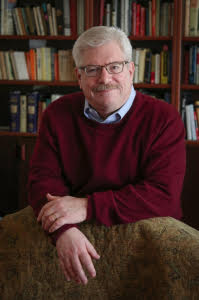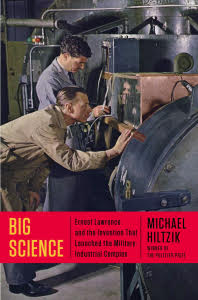By Michael Hiltzik | (Author, Big Science) | – –
This summer — August 6 and 9, to be precise — marks the 70th anniversary of the nuclear bombings of Hiroshima and Nagasaki. Seven decades on, the social, political, and moral implications of birth of the nuclear age still are widely and bitterly debated. Indeed, it’s doubtful that society will ever come to a conclusion about them that satisfies everybody.
One reason is that the debate is waged today through the lens of seventy years of post-Hiroshima history. The bomb didn’t end war, as was dreamed by some of its creators; it certainly didn’t make the world safer; and the uranium and plutonium fission bombs dropped on two Japanese cities turned out to be merely the precursors of technology that even many of the atomic bomb’s creators considered truly genocidal — the hydrogen bomb.
But we may gain some clarity by reexamining the thinking of the atomic bomb’s creators during the very process of its creation, from 1941 through 1945. I had to do that in the process of researching and writing my book “Big Science,” which focuses on the career of one of those creators: Ernest O. Lawrence, the inventor of the cyclotron, the impresario of an entirely new method of conducting large-scale science, and the man who saved the atom bomb project from almost certain extinction in 1941.
In 1941 Ernest Lawrence was the most famous native-born scientist in America, a youthful, engaging personality with a spectacular invention to his name, the unanimous respect of his colleagues in physics, and a Nobel Prize (awarded in 1939). From his perch at the University of California in Berkeley, he had participated in some of the studies of an A-bomb’s feasibility launched after the U.S. and British governments were told of its potential through a letter from Albert Einstein and physicist Leo Szilard in 1939.
When one sees the project through Lawrence’s eyes, one has to recognize why many of the leading physicists in the U.S. and Great Britain — including many who had fled Nazi Germany — felt a sense of urgency to develop and build the bomb, and almost no choice other than to drop it on Japan.
Despite this sense of urgency, those physicists had been reluctant to set their peacetime careers aside to take the bomb a reality. This ambivalence left the men charged with mustering America’s scientific brainpower and resources for the coming war, Vannevar Bush of the Carnegie Institution and James Conant of Harvard, doubtful that an atomic bomb could be developed in time to play a role in the war. They were close to canceling the program outright, for understandable reasons — a war loomed, and any effort that wouldn’t contribute to victory would have to be chopped.
Lawrence turned things around over a single week in September 1941. British physicists had concluded on their own that the bomb was feasible, and could play a decisive role in the war. After they reached out to Lawrence and convinced him, he met with Conant to stave off cancellation. The message he delivered concerned not merely the feasibility of the bomb, but its urgency. The opinion nearly universally shared by physicists in the U.S. and Britain — especially those who had fled Germany and Austria — was that scientists who had stayed behind in the Third Reich were intellectually capable of fashioning a fission bomb, and if such a weapon fell into Hitler’s hands, civilization was doomed.
Meeting over dinner in Chicago, Conant fixed him with a steely look and crisply informed him he needed to back up his argument with action. “Ernest,” he said, “are you ready to devote the next years of your life to getting these bombs made?” Lawrence swallowed hard and replied: “Jim, if you tell me this is my job, I’ll do it.” What was soon dubbed the Manhattan Project was never again in doubt.
Lawrence’s role in the program has long been overshadowed by that of his one-time friend and colleague, J. Robert Oppenheimer, but in many ways his contribution was more important. He was one of an elite group of administrators who guided research policy for the program. He invented the enrichment process that would produce virtually all the uranium that went into the Hiroshima bomb, and supervised its production at a plant he helped design at Oak Ridge, Tenn. It was in his Berkeley lab, using the cyclotron, that his deputy Glenn Seaborg first isolated plutonium, which became the fuel core of the Nagasaki bomb.
Germany’s surrender in May 1945 changed the calculus, but not the momentum, of the bomb project. Unlike Germany, Japan was not regarded as a potential nuclear threat and its regime not seen as fixed on world domination. But by then, work on the bombs was nearly complete, and the impulse to use the new weapon to bring a quick end to the war was strong. Historians have debated ever since then whether the bombing of Japan was truly necessary to secure surrender, but there can be no question that many of those directly involved in the decision accepted the assumption that it was.
Among them was that elite group that had supervised the scientific work on the bomb: Lawrence, Oppenheimer, Arthur Holly Compton of the University of Chicago, and Enrico Fermi. On May 31 they met with Bush, Conant, Secretary of War Henry Stimson, and a few other administration policy-makers to decide how to proceed.
For the first time, a formal government body pondered whether a mere demonstration of the bomb’s power, say over the desert or an uninhabited atoll, might be enough to prompt a Japanese surrender. Lawrence emerged as a powerful voice for a demonstration, but he was a party of one. Oppenheimer was especially doubtful. “We didn’t think that being scientists especially qualified us as to how to answer this question of how the bombs should be used or not,” he recalled years later. He feared that the device he and his team had built at Los Alamos might be a dud. “We did not think that exploding one of these things as a firecracker over a desert was likely to be impressive.”
The scientists retired to Los Alamos to think further. Lawrence, the participants recalled, was the last holdout against a direct attack on Japan. In the end they produced a dispirited one-page memo acknowledging, “we can propose no technical demonstration likely to bring an end to the war; we see no acceptable alternative to direct military use.” The memo was issued in all their names; if Lawrence dissented, he never said so publicly.
By then, anyway, a squadron of B-29 Superfortress heavy bombers already had been assembled on the Pacific island of Tinian, their noses pointed at Japan. A few weeks after the Los Alamos meeting, they staged their two runs, three days apart. Amid the first reports of success, most of the scientists who had built the bomb — many of them unaware until that moment that the technology they had worked on actually had been built — were infused with the thrill of accomplishment. A few had felt qualms in advance. But for many more, the doubts about the new age they had brought about began to surface only after the debris of Hiroshima and Nagasaki settled.
Many of the scientists who developed the atom bomb, including Oppenheimer, would eventually reconsider their roles. Some had begun thinking even before the first bomb was dropped about how to manage the political and social implications of the technology they had helped to invent. Many would work to promote the cause of international control over nuclear technology, recognizing that what Big Science had unleashed could be managed safely only through a new conception of geopolitics. Many others would work to develop nuclear power and other peaceful technologies, perhaps in the hopes of expiating the moral qualms that Hiroshima and Nagasaki had brought them to.
What was clear even before the bombs fell was that by mustering immense financial resources and bringing together thousands of scientists to unleash the terrible forces locked within the atomic nuclear goal, the Manhattan Project had brought about a sea change in scientists’ relationship with society. Manhattan Project physicist James Franck, a German émigré, sounded a critical warning in a report two months before the first atomic bomb detonated over Japan. The age was already past, he observed, in which “scientists could disclaim direct responsibility for the use to which mankind had put their disinterested discoveries.” The reason was that what science had brought about was “fraught with infinitely greater dangers than were all the inventions of the past.” We’re still grappling with the implications of that truth, seventy years later.
Author Bio
Michael Hiltzik, author of Big Science, is a Pulitzer Prize–winning journalist and author who has covered business, technology, and public policy for the Los Angeles Times for three decades. He currently serves as the Times’s business columnist and hosts its business blog, The Economy Hub. His books include The New Deal, Colossus, Dealers of Lightning, and The Plot Against Social Security. Mr. Hiltzik received the 1999 Pulitzer Prize for articles exposing corruption in the entertainment industry. He lives in Southern California with his wife and two children.
For more information please visit http://www.michaelhiltzik.com and follow the author on Twitter.
© 2015 Michael Hiltzik. This piece is adapted from his Big Science: Ernest Lawrence and the Invention that Launched the Military-Industrial Complex





 © 2025 All Rights Reserved
© 2025 All Rights Reserved